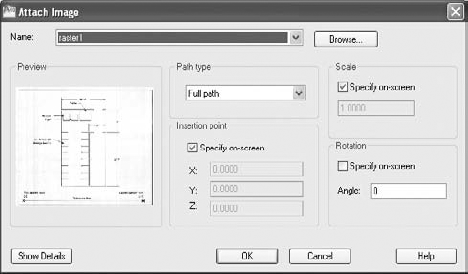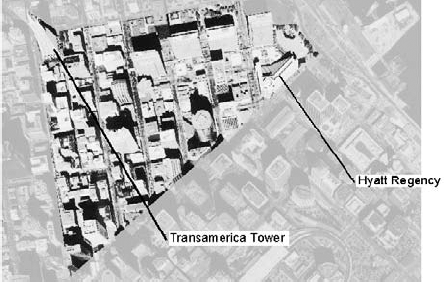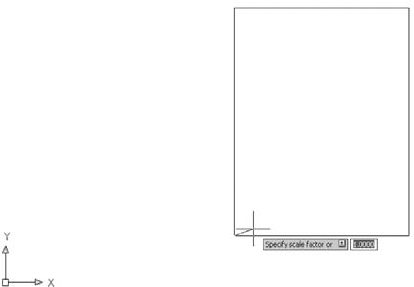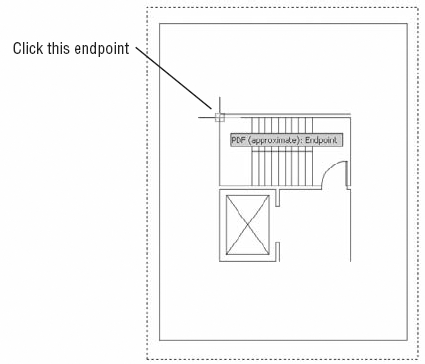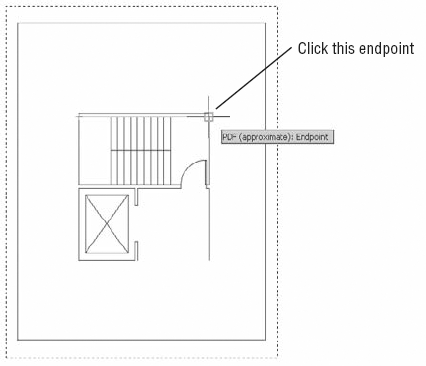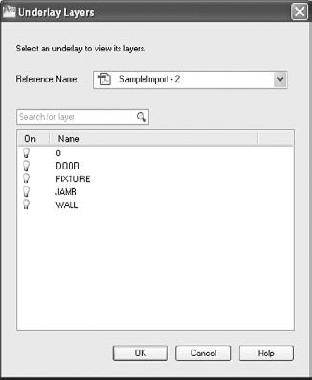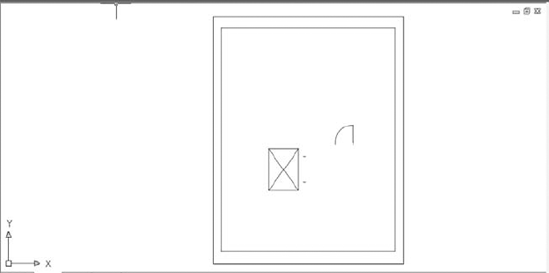At times, you'll want to turn an existing drawing into an AutoCAD drawing file. The original drawing may be hand drawn, or it might be a PDF from another source. You may be modifying a design that someone else created or converting your library of older, hand-drafted drawings for AutoCAD use. Perhaps you want to convert a hand-drawn sketch into a formal drawing? This chapter discusses ways to import existing drawings into AutoCAD through tracing, scaling, and scanning. You'll also lean how to incorporate drawings in a PDF format into your AutoCAD work.
In this chapter, you'll learn to do the following:
Convert paper drawings into AutoCAD files
Import a raster image
Work with a raster image
Work with PDF files
Tracing with a digitizing tablet used to be the only way to enter a hand-drafted drawing into AutoCAD. However, a traced drawing usually requires some cleanup and reorganization.
Scaling a drawing is the most flexible method because you don't need a graphics tablet to do it and, generally, you're faced with fewer cleanups afterward. Scaling also facilitates the most accurate input of orthogonal lines because you can read dimensions directly from the drawing and enter them into AutoCAD. The main drawback with scaling is that if the hand-drafted drawing does not contain written dimensions, it would be difficult to produce an accurate copy. In addition, you must constantly look at the hand-drafted drawing and measure distances with a scale, and irregular curves are difficult to scale accurately.
Programs are available that automatically convert an image file into an AutoCAD drawing file consisting of lines and arcs. These programs may offer some help, but they require some editing and checking for errors.
Scanning, much like tracing, is best used for drawings that are difficult to scale, such as complex topographical maps containing more contours than are practical to trace on a digitizer or nontechnical line art, such as letterhead and logos.
The simplest method for converting paper drawings, and the method I show you in this chapter, is to scan your drawings as image files to be used as a background in AutoCAD. You can import your image files into AutoCAD and then trace directly over them. This technique allows you to see the original drawing in the AutoCAD window, preventing you from diverting your attention to other areas of your workstation.
If you have a scanner and you'd like to use it to import drawings and other images into AutoCAD, you can take advantage of AutoCAD's ability to import raster images. There are many reasons you may want to import a scanned image. In architectural plans, a vicinity map is frequently used to show the location of a project. With the permission of its creator, you can scan a map into AutoCAD and incorporate it into a cover sheet. That cover sheet can also contain other images, such as photographs of the site, computer renderings and elevations of the project, and company logos.
Another reason for importing a scanned image is to use the image as a reference to trace over. You can trace a drawing with greater accuracy by using a scanned image as opposed to a digitizing tablet. Now that the price of a scanner has fallen below $100, it has become a cost-effective tool for tracing a wide variety of graphic material. In this section, you'll learn firsthand how you can import an image as a background for tracing.
Click the External References tool on the Insert tab's Reference panel (Figure 14.1) to open the External References palette, which lets you import a full range of raster image files.
You can also type XR
AutoCAD has a utility called eTransmit that collects AutoCAD files and their related support files, such as raster images, external references, and fonts, into any folder or drive you specify. See Chapter 29 for details.
Another similarity between Xrefs and imported raster images is that you can clip a raster image so that only a portion of the image is displayed in your drawing. Portions of a raster file that are clipped aren't stored in memory, so your system won't get bogged down, even if the raster file is huge.
The following exercise gives you step-by-step instructions for importing a raster file. It also lets you see how scanned resolution translates into an image in AutoCAD. This is important if you're interested in scanning drawings for the purpose of tracing over them. Here are the steps:
Create a new file called
Rastertrace.Set up the file as an architectural drawing with a ¼″=1′ scale on an 8½″ × 11′ sheet (set the Limits settings to 0,0 for the lower-left corner and 528,408 for the upper-right corner). Make sure the drawing units type is set to Architectural. Metric users should set up their drawing at a 1:50 scale on an A4 size sheet. (The Limits settings for metric users should be 0,0 for the lower-left corner and 1480,1050 for the upper-right corner.)

Draw a line across the screen from coordinates 0,20′ to 64′,20′. Metric users should draw the line from 0,600 to 1820,600. You'll use this line in a later exercise.
Click the line you just drew, and then select Red from the Object Color drop-down list in the Home tab's Properties panel. This helps make the line more visible. If you have the Quick Properties feature turned on, you can select the color from the Quick Properties panel.


From the Select Reference File dialog box, locate and select the raster1.jpg project file. You can see a preview of the file on the right side of the dialog box.
Click Open to open the Attach Image dialog box (Figure 14.2). Click OK.
Uncheck the Specify On-Screen option in the Insertion point group to accept the 0,0 coordinates.
Click OK, and then at the
Specify scale factor <1>:prompt, use the cursor to scale the image so it fills about half the screen, as shown in Figure 14.3. Theraster1.jpgfilename appears in the External References palette.
Once you've imported a raster image, you can begin to work with it in a variety of ways. You can resize the image to suit your needs and even adjust its size to a particular scale. Raster images can be made to overlap AutoCAD objects, or you can have raster images appear in the background. There are also rudimentary controls for brightness, contrast, and transparency. In the following sections, you'll continue to use the image you attached to your drawing to explore some of these options.
The raster1.jpg file was scanned as a grayscale image at 100dpi. This shows that you can get a reasonable amount of detail at a fairly low scan resolution.
Now suppose you want to trace over this image to start an AutoCAD drawing. The first thing you should do is to scale the image to the appropriate size. You can scale an image file to full size. Try the following steps to see how you can begin the process:


Click the edge of the raster image to select it.
Press

At the
Specify base point:prompt, click the X in the lower-left corner of the image.At the
Specify scale factor or [Copy/Reference]:prompt, enter R
At the
Specify reference length <1>:prompt, type @
At the
Specify second point:prompt, click the X at the lower-right corner of the image.At the
Specify new length or [Points]:prompt, enter 44′
The image is now scaled properly for the plan it portrays. You can proceed to trace over the image. You can also place the image on its own layer and turn it off from time to time to check your trace work. Even if you don't trace the scanned floor plan line for line, you can read the dimensions of the plan from your computer monitor instead of having to go back and forth between measuring the paper image and drawing the plan on the computer.
With the introduction of raster-image support, AutoCAD inherited a problem that's fairly common to programs that use such images: raster images obscure other objects that were placed previously. The image you imported in the previous exercise, for example, obscures the line you drew when you first opened the file. In most cases, this overlap isn't a problem, but in some situations you'll want AutoCAD vector objects to overlap an imported raster image. An example is a civil-engineering drawing showing an AutoCAD drawing of a new road superimposed over an aerial view of the location for the road.
Paint and page-layout programs usually offer a "to front/to back" tool to control the overlap of objects and images. AutoCAD offers the Draworder command. Here's how it works:

Click the Bring Above Objects tool from the Draworder flyout on the Home tab's Modify panel.

At the
Select objects:prompt, select the horizontal line you drew when you first opened the file.You can select other objects if you wish. Press

At the
Select reference objects:prompt, click the edge of the raster image of the utility room, and then press
The drawing regenerates, and the entire line appears, no longer obscured by the raster image.
The Draworder tool you just used has four options in the Draworder flyout on the Home tab's Modify panel:
- Bring To Front
Places an object or a set of objects at the top of the draw order for the entire drawing. The effect is that the objects are completely visible.
- Send To Back
Places an object or a set of objects at the bottom of the draw order for the entire drawing. The effect is that other objects in the drawing may obscure those objects.
- Bring Above Objects
Places an object or a set of objects above another object in the draw order. This has the effect of making the first set of objects appear above the second selected object.
- Bring Under Objects
Places an object or a set of objects below another object in the draw order. This has the effect of making the first set of objects appear underneath the second selected object.
You can also use the Dr keyboard shortcut to issue the Draworder command. If you do this, you see these prompts:
Select objects: Enter object ordering option [Above objects/Under objects/Front/Back]<Back>:
You must then select the option by typing the capitalized letter of the option.
Although this section discussed the Draworder tools in relation to raster images, they can also be invaluable in controlling visibility of line work in conjunction with hatch patterns and solid fills. See Chapter 7 for a detailed discussion of the Draw Order tools and hatch patterns.
In the following exercise, you'll try the Clip command to control the display of the raster image:
Click the Clip tool from the Insert tab's Reference panel, or type Clip

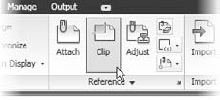
At the
Select object to clip:prompt, click the edge of the raster image.At the
Enter image clipping option [ON/OFF/Delete/New boundary]<New>:prompt, press
At the
[Select polyline/Polygonal/Rectangular/Invert clip] <Rectangular>:prompt, enter P
Select the points shown in the top image in Figure 14.4 and then press

As the prompt in step 3 indicates, you can turn the clipping off or on, or you can delete an existing clipping boundary through the Clip Image option.
After you clip a raster image, you can adjust the clipping boundary by using its grips:
Click the boundary edge of the raster image to expose its grips.
Click a grip in the upper-right corner, as shown in the final image in Figure 14.4.
Drag the grip up and to the right, and then click a point. The image adjusts to the new boundary.
In addition to hiding portions of a raster image that are unimportant to you, clipping an image file reduces the amount of RAM the raster image uses during your editing session. AutoCAD loads only the visible portion of the image into RAM and ignores the rest.
AutoCAD offers a tool that enables you to adjust the brightness, contrast, and strength of a raster image. Try making some adjustments to the raster image of the utility room in the following exercise:
Click the edge of the raster image. The Image tab appears in the Ribbon (Figure 14.5).
In the Adjust panel of the Image tab, click and drag the Fade slider to the right so that it's near the middle of the slider scale, or enter 50 in the Fade input box to the right of the slider. The sample image fades to the AutoCAD background color as you move the slider.
Press the Esc key to un-select the raster image. The Image tab closes.
Save the file as
Rasterimport.dwg.
You can adjust the brightness and contrast by using the other two sliders in the Adjust panel of the Image tab.
By using the Image tab in conjunction with image clipping, you can create special effects. Figure 14.6 shows an aerial view of downtown San Francisco with labels. This view consists of two copies of the same raster image. One copy serves as a background, which was lightened using the method demonstrated in the previous exercise. The second copy is the darker area of the image with a roughly triangular clip boundary applied. You might use this technique to bring focus to a particular area of a drawing you're preparing for a presentation.
If the draw order of objects is incorrect after you open a file or perform a Pan or Zoom, issue a Regen to recover the correct draw-order view.
In addition to the tools in the Adjust panel, the Image tab offers several other tools that can be used to modify raster images. Table 14.1 gives you rundown of their function.
Table 14.1. The Tools on the Image Tab
Tool | Function |
|---|---|
Brightness | Adjust the brightness of an image. |
Contrast | Adjust the contrast of an image. |
Fade | Adjust the fade value of an image. |
Create Clipping Boundary | Allows you to create a clipping boundary. This tools works just like the Clip tool. |
Remove Clipping | Removes a clipping boundary. |
Show Image | Toggles an image on and off. |
Transparency | Toggles the transparency of an image on and off. |
External References | Opens the External References palette. |
You can make three other adjustments to your raster image: frame visibility, image quality, and image transparency.
By default, a raster image displays an outline, or a frame. In many instances, this frame can detract from your drawing. You can turn off image frames globally by typing Imageframe
If your drawing doesn't require the highest-quality image, you can set the image quality to Draft mode. You may use Draft mode when you're tracing an image or when the image is already of a high quality. To set the image quality, enter Imagequality
High mode softens the pixels of the raster image, giving the image a smoother appearance. Draft mode displays the image in a raw, pixilated state. If you look carefully at the regions between the motorcycle and the background in the second image in Figure 14.8, you'll see that the edges of motorcycle appear a bit jagged. The first image in Figure 14.8 uses the High setting to soften the edges of the motorcycle. You may need to look closely to see the difference.
Finally, you can control the transparency of raster image files that allow transparent pixels. Some file formats, such as the CompuServe GIF 89a format, enable you to set a color in the image to be transparent (usually the background color). Most image-editing programs support this format because it's a popular one used on web pages.
When you turn on the Transparency setting, objects normally obscured by the background of a raster image may show through. Enter Transparency
The Properties palette offers many of the same adjustments described in this section, and you can use it for quick access to the Transparency setting and other raster-image settings. You can access the Image Adjust dialog box, hide or display clipped areas, or hide the entire raster image.
If you're using a computer as part of your daily work activity, you will encounter a PDF document. PDFs have become an part of everyday life, so it's no surprise that AutoCAD offers a fair amount of support for PDFs.
In the following sections, you'll learn how to import a PDF document into AutoCAD and how you can control various properties of the document such as fading and the ability to snap to objects in the PDF.
To import a PDF, you use a method similar to the one you used earlier to import an image file. In fact, you could perform all of the steps in the exercise in the section "Importing a Raster Image" earlier in this chapter using a PDF file instead of the raster1.jpg file. You just need to know how to set up the Select Reference File dialog box to allow you to locate PDFs.
Try the following to see firsthand how to import a PDF:
Open a new file using the
Acad.dwtfile as a template.Use the Save As option in the Application menu and save the drawing as
PDFimport.dwg.
In the File Of Type drop-down list at the bottom of the dialog box, select PDF Files (*.pdf).

Locate and select the
Sampleimport.pdfproject file.Click Open to open the Attach PDF Underlay dialog box (Figure 14.9). Notice that you have an option to select a specific page of the PDF document if you are opening a multipage PDF.
Click page 2 of the page preview on the left side of the dialog box.
Click OK, and then at the
Specify insertion point:prompt, place the outline of the drawing so it is roughly centered in the drawing area and click.At the
Specify scale factor <1>:prompt, use the cursor to scale the image so it fills the screen, as shown in Figure 14.10. Page 2 of theSampleimport.pdffile appears in the drawing.
In an earlier exercise, you were able to scale an image file, though you had to use an existing reference line that was already in the image file to roughly scale the drawing to its proper size in AutoCAD. If you have a PDF that was created from an AutoCAD file or from another vector-based program, you can use osnaps to select exact locations in the PDF.
Try the following exercise to see firsthand how you can use osnaps to select geometry in the PDF. You'll scale the drawing so that the width of the stairs conform to the known distance for that area.
First make sure that the Snap To Underlay feature is turned on:
In the Insert tab's Reference panel, click the Snap To Underlay tool.

Select the Snap To Underlay ON option.
Now you are ready to scale the PDF drawing:
Click the Scale tool in the Home tab's Modify panel or type SC

Select the imported PDF drawing and press

At the
Specify base point:prompt, turn on the osnap setting and select the left endpoint of the horizontal line at the top of the drawing, as shown in Figure 14.11.At the
Specify scale factor or [Copy/Reference]:prompt, type R
At the
Specify Reference length:prompt, click the same endpoint again or type @
At the
Specify second point:prompt, click the endpoint of the line shown in Figure 14.12.At the
Specify new length:prompt, enter 196, which is the inch equivalent of 16′-4″. Metric users should enter 498 to match the dimension of the metric version of the lobby drawing.In the View tab's Navigate panel, click the Extents option from the Zoom flyout to center the drawing in the drawing area.
In this exercise, you were able to use object snaps directly on the imported PDF drawing. You may have noticed that a tool tip appeared with the message "PDF (approximate): Endpoint." The PDF drawing is not an exact representation of the original drawing so the tool tip reminds you that even though you are using an osnap to select a location in the drawing, it is not an exact location as it would be in an AutoCAD file.
You can take advantage of a number of other features of a PDF file. Just as with a typical Xref or image file, you can fade the PDF so it appears as a background image. You can also use the Clip feature you saw earlier in this chapter to clip the PDF to a specific area.
You can gain access to these and other PDF display features through the PDF Underlay Ribbon tab. This tab appears automatically whenever you select an imported PDF drawing. Click the PDF drawing of the lobby and you'll see the PDF Underlay tab appear in the Ribbon (Figure 14.13).
Table 14.2 gives a description of the tools in the PDF Underlay Ribbon. The tools are fairly self-explanatory. For example, the tools in the Adjust panel let you control the fade and contrast of the PDF drawing. The Display In Monochrome option displays a color PDF in monochrome.
Table 14.2. The PDF Underlay Tab Tools
One option you'll want to take a closer look at is the Edit Layers tool in the PDF Layers panel. If the source PDF is a drawing that contains layers, you can control the visibility of those layers using this tool. With an imported PDF selected, click the Edit Layers tool to open the Underlay Layers dialog box (Figure 14.14).
You can turn the visibility of a layer on or off by clicking the lightbulb icon to the left of the list. For example, if you turn off the WALL layer in the Underlay Layers dialog box for the Sampleimport example, the PDF drawing will change so that the walls will not be shown (Figure 14.15).
- Convert paper drawings into AutoCAD files
AutoCAD gives you some great tools that let you convert your paper drawings into AutoCAD files. Several options are available. Depending on your needs, you'll find at least one solution that will allow you to convert your drawings quickly.
- Master It
Describe the different methods available in AutoCAD for converting paper drawings into CAD files.
- Import a raster image
You can use bitmap raster images as backgrounds for your CAD drawings or as underlay drawings that you can trace over.
- Master It
Import a raster image of your choice, and use the AutoCAD drawing tools to trace over your image.
- Work with a raster image
Once imported, raster images can be adjusted for size, brightness, contrast, and transparency.
- Master It
Import a raster image of your choice, and fade the image so it appears lighter and with less contrast.
- Work with PDF files
AutoCAD allows you to import and control the display of PDF files. This is significant since the PDF file format is so prevalent in the business world.
- Master It
In a PDF that includes layers, how do you gain access to the layer settings?


